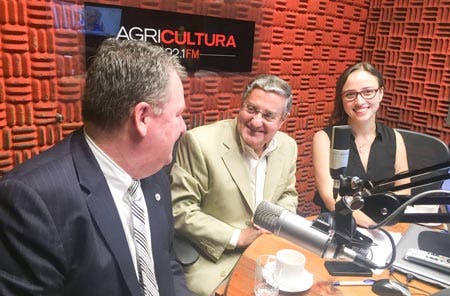USMEF Makes Key Business Contacts on USDA Trade Mission to Peru, Chile

USMEF’s Jessica Julca and John Hinners with USDA Secretary Tom Vilsack at a reception at the U.S. ambassador’s residence in Lima, Peru
USMEF representatives joined U.S. Agriculture Secretary Tom Vilsack and a team of U.S. agricultural and business leaders on a USDA trade mission to Peru and Chile, March 14-18. John Hinners, USMEF assistant vice president for industry relations, was part of the U.S. delegation visiting both countries. Jessica Julca, USMEF’s South America representative based in Lima, Peru, also participated in the Peru segment of the trade mission.
Following a Monday briefing by staff members from the U.S. Embassy in Lima, the delegation took part in a full day of business-to-business meetings with importers and other key contacts from Peru. This was followed by a dinner at the La Huaca Pucllana restaurant, which showcased U.S. meat cuts that are popular for use in Peruvian cuisine.
Also on Monday, USDA and the Office of the U.S. Trade Representative announced that Peru had agreed to allow full access for U.S. beef and beef products, lifting BSE-related restrictions and eliminating the need for an export verification (EV) program for Peru. Elimination of the EV program means that Peru’s ban on beef derived from direct-slaughter cattle of Canadian origin is no longer in effect, and all bone-in cuts from cattle of all ages are now eligible for export to Peru.

John Hinners and Jessica Julca meet with Peruvian meat buyers as part of a USDA trade mission
“This is an important step that will allow for further growth of U.S. beef exports to Peru,” said Julca. “Elimination of the EV program lowers production costs for U.S. suppliers serving Peru, which is critical in a market where we face significant competition.”
After another full day of meetings with Peruvian business leaders on Tuesday, the delegation moved on to Santiago, Chile, where U.S. Embassy staff provided an overview of the Chilean economy and business climate. This set the stage for many productive meetings with Chilean importers and other business leaders from this promising market, which has a population of more than 18 million and the highest per-capita GDP of any South American country.
Peru and Chile are participants in the Trans-Pacific Partnership (TPP), but U.S. red meat already has favorable access to these countries through previous free trade agreements. All U.S. beef and pork exports now enter Chile at zero duty. The situation is effectively the same for Peru, where duties have been eliminated for pork as well as for beef cuts graded Choice and Prime. Other beef muscle cuts and variety meats enter Peru under duty-free quotas. All remaining duties on beef will be eliminated by 2020.
“These trade agreements have helped create significant growth opportunities for U.S. beef and pork exports to Chile and Peru,” Hinners explained. “The trade mission allowed us to show USDA and other U.S. industries how USMEF has assisted U.S. exporters in capitalizing on these opportunities. It was truly an honor to be invited to accompany Secretary Vilsack on this trip, and to represent the U.S. meat industry in these dynamic, emerging markets.”
The U.S. red meat industry also gained positive exposure through the media while on the USDA trade mission. Hinners and Julca met with business reporters in Peru, including a special correspondent from Bloomberg News. In Chile, Hinners conducted a live radio segment with Radio Agricultura – a major business broadcasting outlet based in Santiago.

John Hinners discusses the attributes of U.S. beef and pork with Chilean broadcasters Alejandro de la Carrera and Patricia Venegas on Radio Agricultura’s morning program “Grand Interactive Drive”
